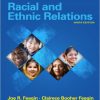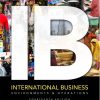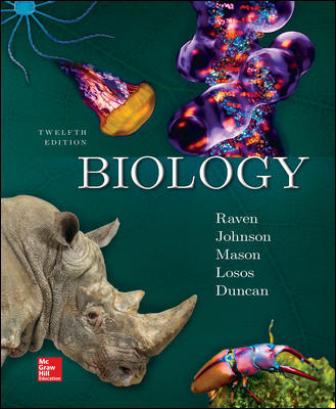Test Bank for Biology 12th by Raven
$35.00 Original price was: $35.00.$26.50Current price is: $26.50.
Test Bank for Biology 12th by Raven
Instant download Test Bank for Biology 12th by Raven pdf docx epub after payment.
Chapter 1 The Science of Biology
1) Science is subdivided into specific areas of study termed disciplines. These divisions are artificial but are helpful to narrow the massive scope of scientific knowledge to a manageable amount. Given what you know about each, which scientific division is likely to present the best answer to a question about how fluid dynamics affect blood pressure in mammals?
- A) Biochemistry – study of chemical reactions needed for life function, usually at the cellular level.
- B) Bioinformatics – use of technology to study and store biological data
- C) Biophysics – study of biological processes through physics
- D) Biology – study of life
2) Based on hierarchical levels of biological organization, which of these choices represents the broadest level?
- A) Endocrine system
- B) 3 toed sloths
- C) School of piranhas
- D) Amazon Basin
- E) Jaguars, giant anteaters, macaws, capybaras
3) Experiments are carried out to test a hypothesis by changing one variable at a time and including an unchanged variable termed a(n) ________.
- A) experimental variable
- B) altered variable
- C) control
- D) stable variable
4) The method of reasoning that uses construction of general principles by careful examination of many specific cases is called:
- A) deductive reasoning.
- B) theoretical reasoning.
- C) hypothetical reasoning.
- D) inductive reasoning.
- E) experimental reasoning.
5) Dr. Ratard was trying to determine the cause of a mysterious epidemic affecting fish in the gulf of New Mexico. His proposal that the deaths were caused by an organism called a protist is considered a(n) ________
- A) experiment.
- B) hypothesis.
- C) conclusion.
- D) theory.
- E) data set.
6) After Darwin concluded his voyage on the Beagle, he proposed that the process of natural selection was a mechanism for:
- A) artificial selection.
- B) evolution.
- C) sexual selection.
- D) speciation.
- E) overpopulation of finches on the Galapagos Islands.
7) A scientific theory is:
- A) a suggested explanation that accounts for observations.
- B) a way to organize how we think about a problem.
- C) a concept that is supported by experimental evidence that explains the facts in an area of study.
- D) a way to understand a complex system by reducing it to its working parts.
8) What common life characteristic would cells from a daisy, bacteria, and a dog all have?
- A) DNA
- B) cell walls
- C) organs
- D) ability to conduct photosynthesis
9) A yellow jacket, an insect in the order Hymenoptera, stung me. A wasp, an insect in Hymenoptera, stung me. A hornet, an insect in Hymenoptera, stung me. I see a pattern. All insects in this order must have stingers. What type of reasoning does this represent?
- A) inductive reasoning
- B) deductive reasoning
- C) reductionism
- D) comparative reasoning
10) You explain to your study group that a hypothesis is:
- A) an explanation that accounts for careful observations.
- B) a proposition that will be true and fits the known facts.
- C) a theory.
- D) constant over time.
11) A suggested explanation that might be true and is subject to testing by further observations is a(n):
- A) experiment.
- B) generality.
- C) hypothesis.
- D) scientific principle.
- E) theory.
12) Based on the literature, you hypothesize that students in traditional biology lectures will have the same grades as students in online biology lectures. You decide to test your hypothesis by comparing grades of students in traditional and online biology lectures over a semester. As a result of the experiment, you observe that the grades in the traditional lectures and the grades in the online lectures are not significantly different. What do these observations allow you to do?
- A) reject the hypothesis
- B) accept the hypothesis without further question
- C) develop a scientific theory
- D) reject the null hypotheses
13) Your microwave will not turn on, and you speculate that a circuit breaker in the house has been tripped. In scientific terminology, the steps would be described as:
- A) forming conclusions from the results of experiments.
- B) developing an observation based on a hypothesis.
- C) developing a hypothesis based on an observation.
- D) testing a prediction generated from a hypothesis.
14) A student poses the question: How does the presence of dissolved salt affect the freezing point of water? To answer this question, the student set up two conditions. In the first condition, the student added salt to water in a container and referred to this condition as the variable. In the second condition, the student did not add any salt to water in a second container and referred to this condition as the control. The student took both containers and attempted to freeze the water at various temperatures to assess the freezing point. Would this be a valid experiment?
- A) Yes, because there is more than one variable.
- B) Yes, because there is one variable and a control
- C) No, because there is not more than one variable
- D) No because there is only one variable and a control
15) Karl Popper suggested that scientists use “imaginative preconception,” which means that successful scientists:
- A) often predict the outcome of experiments.
- B) cannot predict the outcome of experiments.
- C) do not need to do experiments to test their ideas.
- D) do not keep records of experiments that fail.
- E) only perform applied research.
16) The proposal that one type of organism can change gradually into another type over a long period of time is known as:
- A) evolution.
- B) natural history.
- C) preconception.
- D) preservation.
17) Darwin’s ideas on evolution were advanced for his time. His approach to science and natural selection were supported by what main tenet?
- A) Various organisms and their structures resulted from a spontaneous action.
- B) Species were unchangeable over the course of time.
- C) The world is fixed and constant.
- D) Operation of natural laws produces constant change and improvement.
18) Besides Darwin, the theory of evolution by means of natural selection was also independently proposed by:
- A) Alfred Wallace.
- B) Charles Lyell.
- C) Thomas Malthus.
- D) Karl Popper.
- E) Peter Raven.
19) The term that Darwin used to describe the concept that those with superior physical, behavior or other attributes are more likely to survive than those that are not so well endowed, and thus are more likely to pass their traits to the next generation, is called:
- A) biological diversity
- B) geometric progression
- C) natural selection
- D) superior beings
- E) survival of modifications
20) A key contribution to Darwin’s thinking was the concept of limits put on the geometric growth of populations by nature, originally proposed by:
- A) Charles Lyell.
- B) Thomas Malthus.
- C) Karl Popper.
- D) Peter Raven.
- E) Russel Wallace.
Related products
Test Bank
Test Bank for Clinical Immunology and Serology A Laboratory Perspective, 3rd Edition: Stevens












